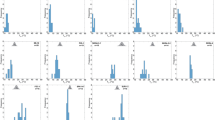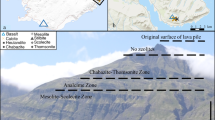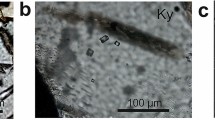Abstract
OXYGEN isotope fractionation in the calcite–water system is widely used to investigate the temperature, fluid composition and reaction rate of calcite precipitation, under the assumption that equilibrium is maintained during precipitation. Here I present analyses of coarsely crystalline, inorganic calcite displaying combined growth and sector zoning, which show this assumption to be untrue. Variations in the isotope composition of successive growth zones can be interpreted as due to changing conditions of precipitation, with equilibrium being maintained throughout. But variations across different sectors of the same synchronous growth surface (∼2‰ for δ13C and ∼0.9‰ for δ18O) record disequilibrium in the same crystal. This type of disequilibrium may be common, as calcite precipitates in a great variety of crystal form combinations; moreover, many noncarbonate minerals also grow as crystals with two or more crystallographic forms. Indeed, Boyd et al.1 reported fractionation of nitrogen isotopes between cubic and octahedral sectors of a synthetic diamond, but I believe that crystallographi-cally controlled isotope fractionation of stoichiometric ions has not hitherto been recognized.
This is a preview of subscription content, access via your institution
Access options
Subscribe to this journal
Receive 51 print issues and online access
$199.00 per year
only $3.90 per issue
Buy this article
- Purchase on Springer Link
- Instant access to full article PDF
Prices may be subject to local taxes which are calculated during checkout
Similar content being viewed by others
References
Boyd, S. R., Pillinger, C. T., Milledge, H.J., Mendelssohn, M. J. & Seal, M. Nature 331, 604–607 (1988).
McCrea, J. M. J. chem. Phys. 18, 849–857 (1950).
Bottinga, Y. J. chem. Phys. 72, 800–808 (1968).
Epstein, S. et al. Geol. Soc. Am. Bull. 64, 1315–1326 (1953).
Clayton, R. N. J. chem. Phys. 34, 724–726 (1961).
Tarutani, T. et al. Geochim. cosmochim. Acta. 33, 987–996 (1969).
O'Neil, J. R. et al. J. chem. Phys. 51, 5547–5558 (1969).
Land, L. S. Handbook of Environmental Isotope Geochemistry 3 (eds Fritz, P. & Fontes, J. Ch.) 191–217 (Elsevier, Amsterdam, 1989).
Turner, J. V. Geochim. cosmochim. Acta. 46, 1183–1191 (1982).
Prezbindowski, D. R. Carbonate Cements Spec. Publ. 36 (eds Schneiderman, N. & Harris, P. M.) 241–264 (SEPM, Tulsa, 1985).
Lawrence, J. R. et al. Init. Rep. Deep-Sea Drilling Proj. 507–512 (US Government Printing Office, Washington DC, 1976).
Banner, J. L. & Hanson, G. N. Geochim. cosmochim. Acta. 54, 3123–3137 (1990).
Dickson, J. A. D. et al. Geology 18, 809–811 (1990).
Reeder, R. J. & Grams, J. C. Geochim. cosmochim. Acta. 51, 187–194 (1987).
Searl, A. Mineralog. Mag. 54, 501–507 (1990).
Author information
Authors and Affiliations
Rights and permissions
About this article
Cite this article
Dickson, J. Disequilibrium carbon and oxygen isotope variations in natural calcite. Nature 353, 842–844 (1991). https://doi.org/10.1038/353842a0
Received:
Accepted:
Issue Date:
DOI: https://doi.org/10.1038/353842a0
This article is cited by
-
Carbon and nitrogen isotope, and mineral inclusion studies on the diamonds from the Pozanti–Karsanti chromitite, Turkey
Contributions to Mineralogy and Petrology (2018)
-
Combining in situ isotopic, trace element and textural analyses of quartz from four magmatic-hydrothermal ore deposits
Contributions to Mineralogy and Petrology (2013)
-
Carbon isotope anatomy of a single graphite crystal in a metapelitic migmatite revealed by high-spatial resolution SIMS analysis
Contributions to Mineralogy and Petrology (2011)
-
Crystal faces
Nature (1992)
-
Surfaces make a difference
Nature (1991)
Comments
By submitting a comment you agree to abide by our Terms and Community Guidelines. If you find something abusive or that does not comply with our terms or guidelines please flag it as inappropriate.



